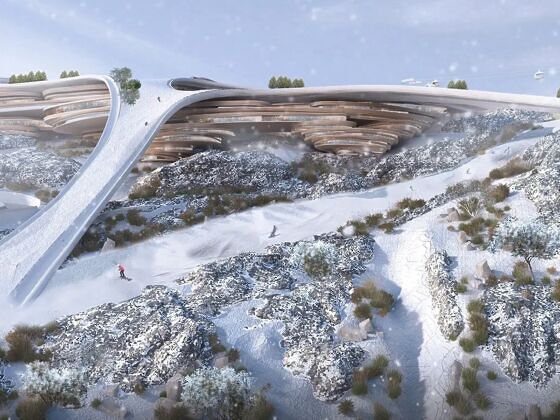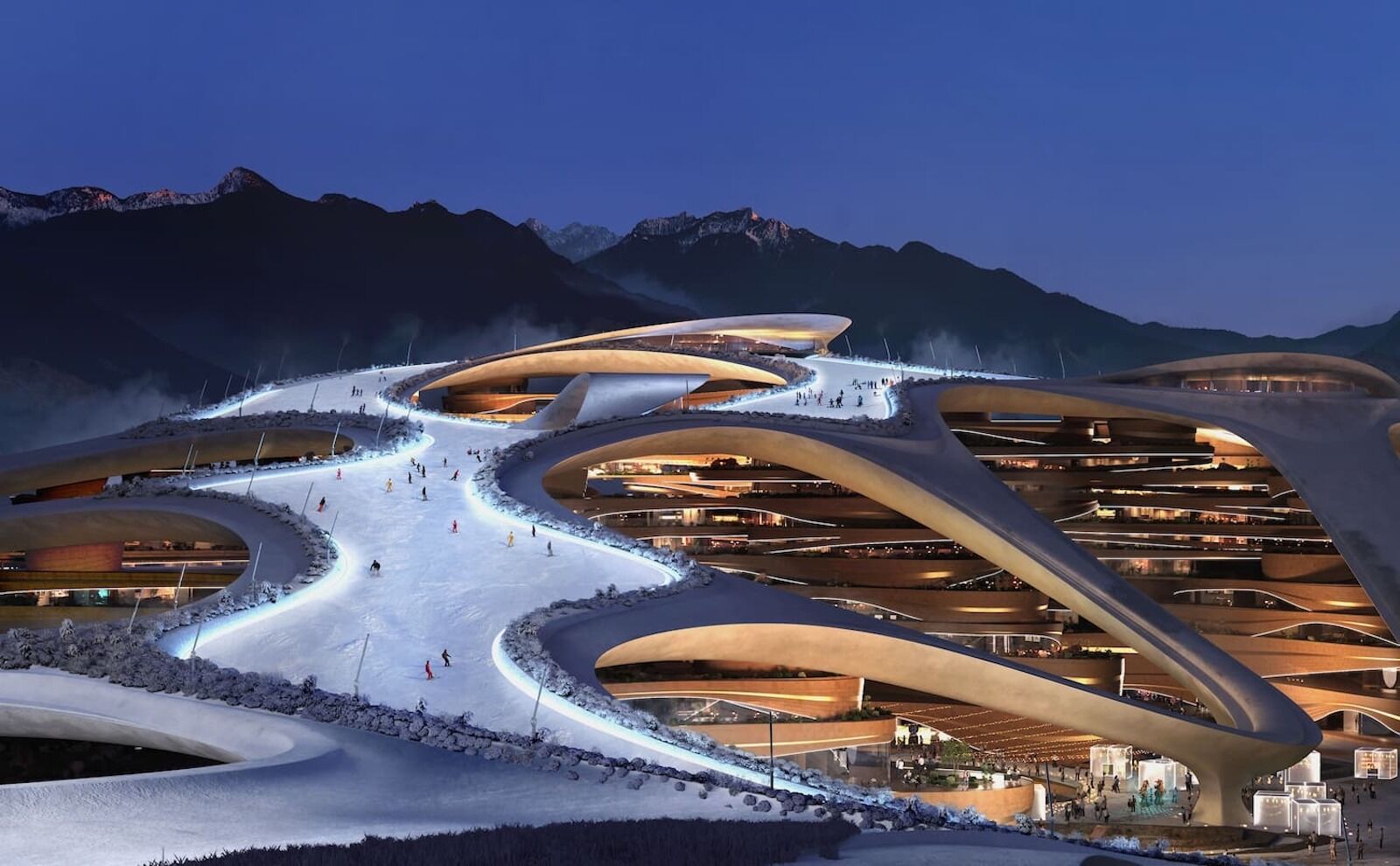In the heart of the Arabian Peninsula, a remarkable transformation is underway in the form of NEOM, Saudi Arabia’s ambitious project that serves as the center of the country’s pivot to becoming a global tourism destination. Trojena, Saudi Arabia’s forthcoming ski resort, is being developed as an unexpected haven for winter sports enthusiasts, drawing attention worldwide ahead of its projected opening in 2026. This groundbreaking resort – a $500 billion part of the broader NEOM project – will bring skiing to the high desert of northern Saudi Arabia, blending traditional Saudi culture with the allure of winter sports. This, of course, raises a lot of questions, from how the resort will get snow to what the experience of skiing there will be like.


Saudi Arabia Is Building a Cutting-Edge, World-Class Ski Resort in the High Desert
Desert skiing: The genesis of Trojena

Photo courtesy of Trojena
Trojena, being built in the stunning mountainous region of Tabuk Province bordering the Red Sea in the northwest corner of the country, represents a visionary shift in Saudi Arabia’s approach to tourism. It all began with the ambitious Vision 2030 program, spearheaded by Crown Prince Mohammed bin Salman. This initiative aims to diversify the Saudi economy and promote tourism by unlocking the country’s untapped potential through projects like The Line, Hidden Marina, Leyja, and more.
The concept of Trojena was born from a desire to make use of the region’s natural beauty and unique geological features, such as its rugged terrain and chilly winters. Temperatures often dip below freezing here, and the region receives moderate natural snow. Developers sought to create a year-round attraction that would not only cater to international tourists but also provide a new recreational space for Saudis themselves.
Constructing Trojena is an engineering marvel in itself. The site sits at an altitude of approximately 8,800 feet. Trojena’s ski slopes are equipped with top-notch snowmaking equipment, ensuring a consistent and reliable snow cover. The resort expects to feature several ski runs of varying difficulty levels, accommodating beginners and seasoned skiers alike, though if you’re a backcountry hound, you’re better off bringing climbing gear instead of skis. Visitors can also enjoy snowboarding, snowshoeing, and other winter sports activities.
Ensimore was announced as the first hotel partner at the resort. The company’s 25hours and Morgans Originals hotel brands will have outposts there when the resort first opens. Wellness programs, guided tours, and group retreats will be available at Trojena, though details are currently scarce. The architecture will be built to resemble the region’s natural surroundings, employing a minimalist aesthetic that (at least on the outside) blends into the landscape.
The Trojena experience
Trojena is set to be much more than a ski hill. The resort’s accommodations are headlined by The Vault, a “vertical village” that will house hotel rooms and apartments alongside shopping, dining, and entertainment. Visitors can embark on a thrilling ski adventure during the day and then unwind in the evenings in the luxurious lodges while enjoying traditional Saudi cuisine and hospitality.
The snow-covered peaks of Trojena provide a surreal contrast to the surrounding arid landscape, and the fact that much of this resort will be artificial slopes and inclines should create quite the spectacle. You’ll be able to carve your way down pristine runs while taking in panoramic views of the desert expanse, for example, and then unstrap and walk into a luxury boutique.
For those looking to take a break from skiing, the resort offers a range of activities.
Snowshoeing through the crisp snow, snowmobile rides, and ice skating are just a few options. Additionally, the Trojena Adventure Park caters to adrenaline junkies with zip-lining and challenging obstacle courses.
Sustainable development
One of the critical aspects of Trojena’s development is its commitment to sustainability. In an era of increasing environmental awareness, the project places a strong emphasis on preserving the fragile mountain ecosystem and conserving water resources. Cutting-edge environmental practices, such as snow recycling and renewable energy sources, are integral to the resort’s operations.
One thing the resort developers have done is to engage with local communities to ensure that the resort benefits the region economically. The project has created numerous job opportunities and stimulated local businesses, contributing to the socioeconomic development of Tabuk Province. It’s also important to note that the NEOM project as a whole represents humanity learning from past mistakes and moving forward, for better or worse, with the development of a region based on forward-thinking practices of sustainability rather than following the high-impact development practices behind nearly all cities and resorts currently operating around the world.
Of course, developing cities and resorts in the desert, where fresh water and resources are scarce, is far from sustainable on its own. The resort will be powered by a mix of solar and wind energy. Water will be pumped from the sea and desalinated, rather than relying on the scarce water available in the region. Given the increased strain on global freshwater supplies, headlined in the US by the current plight of the Colorado River, if Trojena’s developers can implement a minimal-impact system for providing desalinated water to residents and visitors, this could become a model for developers the world over to build upon.
Cultural connection
Trojena will not just be a winter sports destination, but a cultural bridge between ancient traditions and modern recreation. Developers promise nearly half a million square feet of retail space, over 3,500 hotel rooms and apartments, and a 3,000-person amphitheater that will host live music and other events. The resort has pledged to celebrate Saudi Arabia’s rich heritage through its architecture, cuisine, and activities. Visitors have the opportunity to immerse themselves in the local culture, enjoying traditional music, dance, and storytelling.
The broader significance of Trojena
Beyond its role as a premier ski destination, Trojena holds broader significance in the context of Saudi Arabia’s Vision 2030. It represents a tangible demonstration of the country’s commitment to diversifying its economy and promoting tourism. This, in effect, is as much a part of the project’s sustainable design as anything else, because right now, oil and gas accounts for nearly half of Saudi Arabia’s GDP and the industry employs hundreds of thousands of Saudis. As the global economy transitions away from fossil fuels, those people will need jobs, and while the transition into a new line of work is never perfectly smooth – nor should it be assumed that anyone wants to or should be forced to work in tourism – having a diverse array of jobs available is critical. Trojena stands as a symbol of Saudi Arabia’s willingness to embrace innovation and modernity while respecting its cultural roots.
Trojena contributes to the country’s efforts to reduce its dependence on oil revenue, thereby increasing economic stability. Developers estimate 10,000 jobs will be generated by the Trojena project. The revenue generated from tourism, coupled with sustainable practices, positions the resort as a model for responsible development in the region.
How to plan a trip to Trojena
The nearest major airport to Trojena is Tabuk Regional Airport (TUU), located approximately 60 miles away. Travelers can reach Tabuk via domestic flights from Saudi Arabia’s major cities, such as Riyadh, Jeddah, and Dammam. Upon arrival in Tabuk, opt for a rental car or arrange for transportation to Trojena, taking in the scenic drive through the picturesque mountainous terrain.
Prices may change between now and when the resort opens, and it’s likely that direct transfer services will arise between now and then. Domestic flights to Tabuk from major cities in Saudi Arabia can range from approximately $50 to $150 or more, depending on the time of booking and class of service. Accommodation options at Trojena should cater to a range of budgets, with luxury lodges and chalets offering premium experiences, while more affordable options are also available. A night’s stay at one of the mid-range lodges is expected to cost $150 to $300, with the more lavish accommodations surpassing $500 per night. Additionally, lift passes and access to skiing facilities are priced separately, with day passes projected to start at around $50.